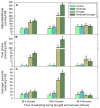Assessment of the Biochemical Responses of Wheat Seedlings to Soil Drought after Application of Selective Herbicide
- PMID: 33918750
- PMCID: PMC8070100
- DOI: 10.3390/plants10040733
Assessment of the Biochemical Responses of Wheat Seedlings to Soil Drought after Application of Selective Herbicide
Abstract
Drought is a major environmental constrain with a deleterious effect on plant development leading to a considerable reduction of crop productivity worldwide. Wheat is a relatively drought tolerant crop during the vegetative stage. The herbicide Serrate® (Syngenta) is a preparation containing two active chemical substances with different modes of action, which inhibit the biosynthesis of fatty and amino acids. It is commonly used as a systemic and selective chemical agent to control annual grass and broadleaf weeds in cereal crops and particularly in wheat, which is tolerant to Serrate®. Seventeen-day-old wheat seedlings (Triticum aestivum L., cv. Sadovo-1) grown as soil culture under controlled conditions were sprayed with an aqueous solution of Serrate®. Seventy-two hours later the plantlets were subjected to drought stress for seven days to reach a severe water deficit followed by four days of recovery with a normal irrigation regime. Oxidative stress markers, non-enzymatic, and enzymatic antioxidants were analyzed in the leaves of plants from the different treatment groups (herbicide-treated, droughts-stressed, and individuals which were consecutively subjected to both treatments) at 0, 96, and 168 h of drought stress, and after 96 h of recovery. Herbicide treatment did not alter substantially the phenotype and growth parameters of the above-ground plant parts. It provoked a moderate increase in phenolics, thiol-containing compounds, catalase, superoxide dismutase, glutathione reductase, and H2O2. However, significant variations of malondialdehyde, proline, and peroxidase activity caused by the sole application of the herbicide were not detected during the experimental period. Drought and herbicide + drought treatments caused significant growth inhibition, increased oxidative stress markers, and activation of enzymatic and non-enzymatic antioxidant defense reaching the highest levels at 168 h of stress. Plant growth was restored after 96 h of recovery and the levels of the monitored biochemical parameters showed a substantial decline. The herbicide provoked an extra load of oxidative stress-related biochemical components which did not aggravate the phenotypic and growth traits of plants subjected to drought, since they exhibited a good physiological status upon recovery.
Keywords: antioxidants; drought; herbicide; stress markers; wheat.
Conflict of interest statement
The authors declare no conflict of interest.
Figures





References
-
- NASA, World of Change: Global Temperatures. [(accessed on 19 March 2021)]; Available online: https://earthobservatory.nasa.gov/Features/WorldOfChange/decadaltemp.php.
-
- Hatfield J.L., Prueger J.H. Temperature extremes: Effect on plant growth and development. Weather. Clim. Extrem. 2015;10:4–10. doi: 10.1016/j.wace.2015.08.001. - DOI
-
- Hasanuzzaman M., Mahmud J.A., Anee T.I., Nahar K., Islam M.T. Drought stress tolerance in wheat: Omics approaches in understanding and enhancing antioxidant defense. In: Zargar S., Zargar M., editors. Abiotic Stress-Mediated Sensing and Signaling in Plants: An Omics Perspective. Springer; Berlin/Heidelberg, Germany: 2018. pp. 267–307.
Grants and funding
LinkOut - more resources
Full Text Sources
Other Literature Sources

